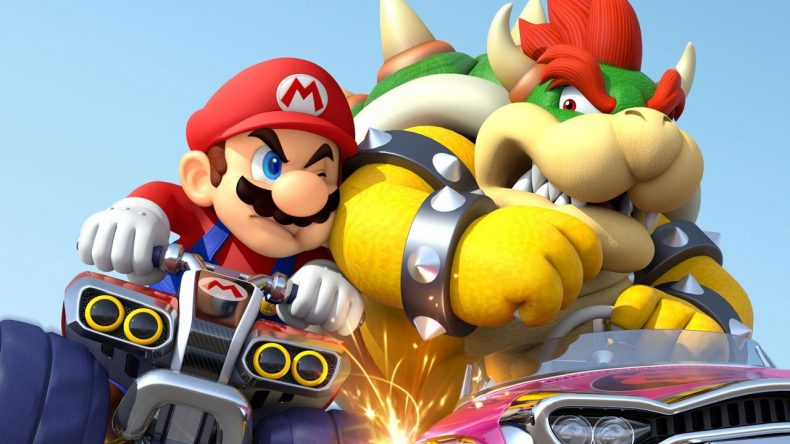As I continue my journey down the perilous road of ranking some of Nintendo‘s most-loved franchises, our attention this time turns to arguably Mario’s favourite recreational hobby – go-karting – in the form of the Mario Kart series. Unlike the Mario and Zelda lists that have gone before, this time I have opted to rank all the mario kart games in the series rather than just a top 5. Mainly that’s because for this series, there are only 8 (real) entries to talk about, and so it made sense to include them all rather than arbitrarily exclude three.
As with all these lists, they are just my personal opinion of which games I feel are better than others. Feel free to disagree, and I in fact encourage you to let me know your thoughts in the comments section below. So without further ado, let’s power(slide) on through!
#8 Mario Kart 7
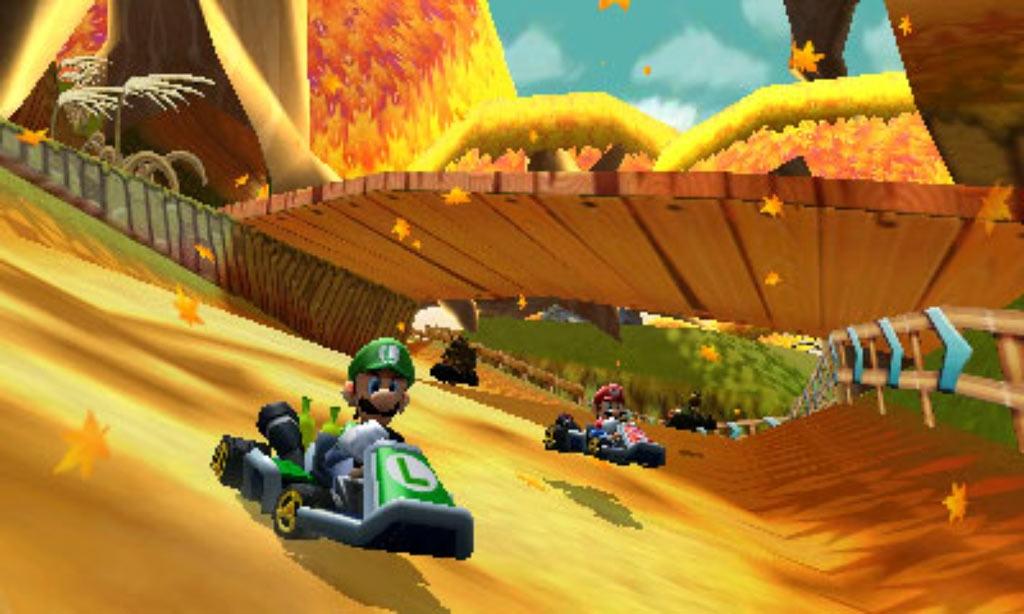
Thanks to Mario Kart 7, I can quash the theory that all Mario Karts are simply improving on the previous game in the series, thus making this list pointless. For me this game was one of those weird experiences where you can’t deny you’re having fun with it, but you’re still ultimately left feeling disappointed. You see Mario Kart 7 wasn’t a bad game by any stretch, but it just felt like it did nothing new to the series, it didn’t bring any meaningful additions, and as such felt a bit of a hollow experience. Certainly compared to other Mario Kart games at least. You felt like you’d been through this all before, and there was nothing new to master.
What’s worth remembering is that Mario Kart 7 did have new stuff in it. It wasn’t that Nintendo didn’t try new things. The big new addition was the customisation options through various tyres, frames and gliders which affected the stats of your kart. Previously, this had been mainly linked solely to the character you chose, but now this gave you more options. The problem was, most of these felt largely cosmetic, and as such I rarely experimented with it, which I imagine was the draw. It’s hard being in last place – especially for a racer – and as I’ve said Mario Kart 7 is still a very fun experience, it’s just that other entries in the series have done it better.
#7 Mario Kart Wii
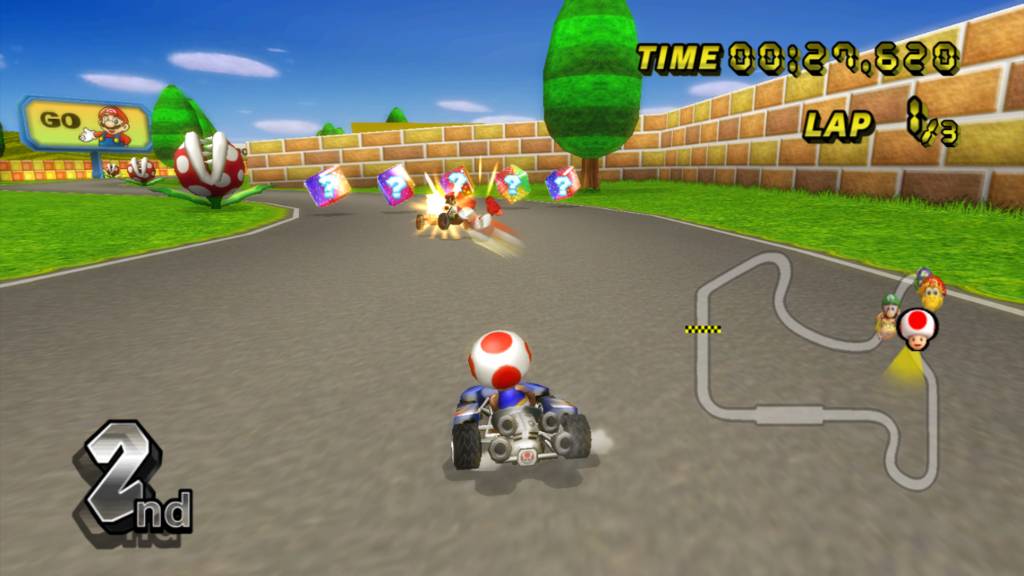
Another theory debunked here, and that’s the idea that numbers are all that matters. Indeed if all I was basing this list on was software sales figures, Mario Kart Wii would be out in first place, taking the chequered flag. Its accomplishment of shifting an eye-watering 37 million copies should not be overlooked – that makes it the 7th bestselling game ever made, and is more than triple what any other console Mario Kart has ever achieved. Truly staggering when you take a step back and reflect. So why is this game not higher on the list?
Well perhaps the biggest gripe of the game was the seemingly deliberate decision to forgo the benefit of being a skillful racer in lieu of closer racing by giving everyone a chance of victory. This was evident not only in single player modes, with the most extreme examples of rubber-banding AI in the series at the higher cc Grand Prix events, but also in races in general with the inclusion of additional game-changing items for the back of the pack to use to gain an advantage. There was even an item the front of the pack could get that whilst giving you a speed boost for a time would eventually cause you to spin out and shrink, as if you didn’t have enough to worry about. Just having to contend with the odd Blue Shell or Lightning from Mario Kart 64 seemed like a distant memory. And whilst I do appreciate that a more balanced racer that gives everyone a chance of winning irrespective of their skill does promote a more fun, friendly experience in local multiplayer, in single player or online it ruins the experience, as you could be punished out of pure bad luck, which can feel incredibly unfair.
Mario Kart Wii did bring some interesting additions to the series, notably the inclusion of bikes, as well as various different control methods, utilising the Wii Wheel peripheral, Nunchuk, classic controllers and more. Its tracks were also well-designed, complete with shortcuts and secrets, even if this meant that they were on the lengthy side when compared to other courses in the franchise. This game was essentially the Mario Kart game for everyone, proved not least by its incredible appeal to that larger 37 million strong audience. But also because it designed itself around being accessible to all, but potentially to the detriment of longer term fans of the series.
#6 Mario Kart Super Circuit
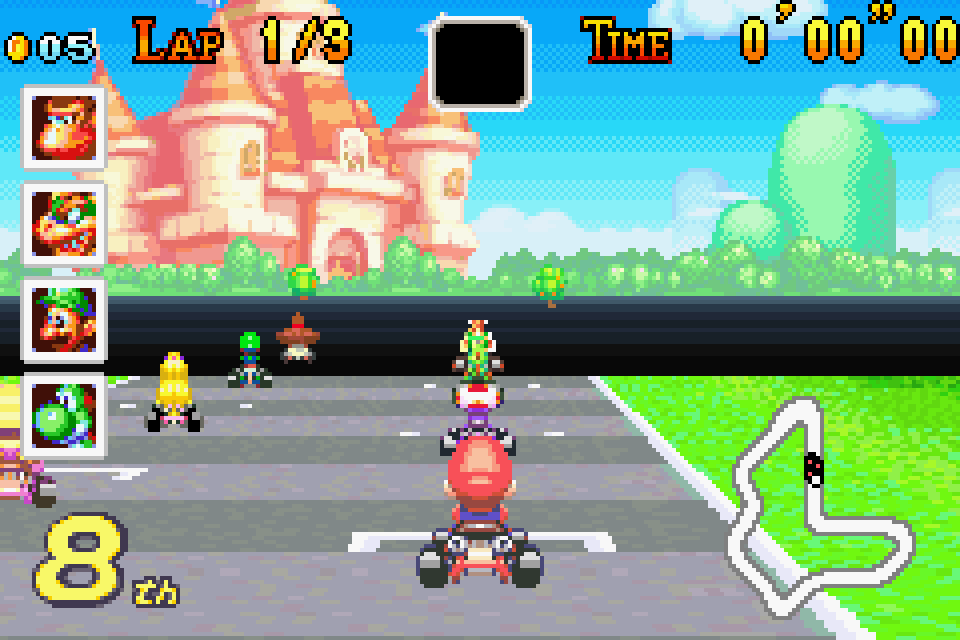
Mario Kart Super Circuit misses out on a top 5 position purely down to what it is competing against rather than being a particularly flawed game. In fact if anything what was achieved back in 2001 to squeeze a kind of mix between both Super Mario Kart and Mario Kart 64 onto a handheld machine was pretty staggering. For a handheld game to look the way it did and play the way it did was an accomplishment in itself, and isn’t something that should be lost despite the passing of time. For the first time we could play a Mario Kart game wherever we liked, without being confined to a TV, and that was a special moment for those that got to experience it.
It would be fair to say that it didn’t take many risks or do much new to what had been established already on consoles, and some may try to argue that this was enough to give Mario Kart 7 a beating, so why not this? The fact of the matter is that purely its portable format made it feel different enough, it made the experience feel new and different, and bought that Mario Kart feeling of joy and excitement that often felt a little lacking in Mario Kart 7.
True, the game was the lowest selling game in the series, and truer still was the fact that even future portable entries in the franchise would be even better, but you shouldn’t overlook what Super Circuit managed to achieve. The two games it amalgamated were clearly franchise highlights (given they’ve not been discussed yet) and to seamlessly package that up with a blend of new and familiar tracks and characters created an overall package that showcased Nintendo at their technological best.
#5 Mario Kart 64
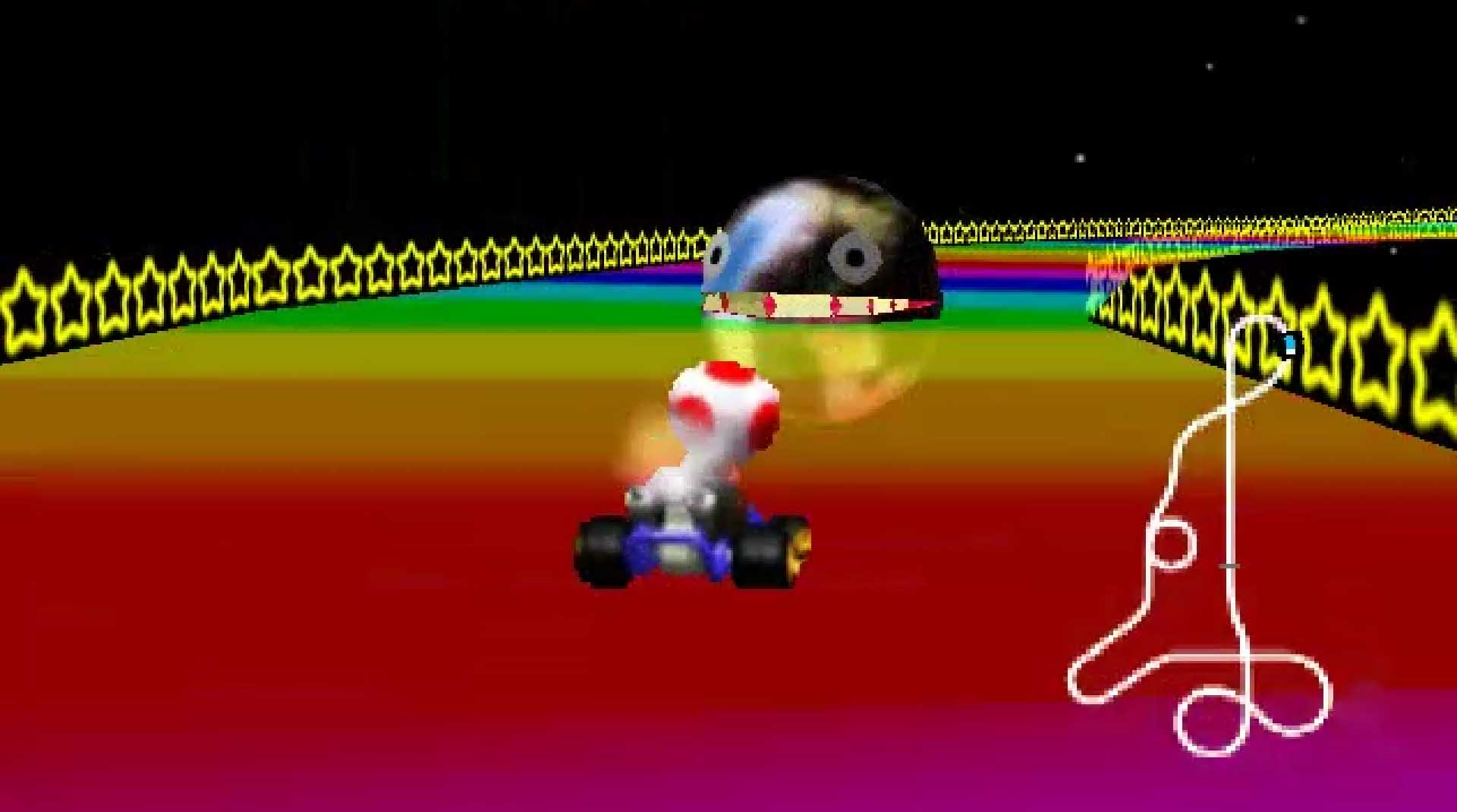
Of all the rankings, this one is where my heart is most misaligned with my head. Growing up I absolutely adored this game, spent countless hours on it after school with friends in local multiplayer, and also countless hours on my own perfecting time trials and trying to nail the infamous shortcuts. If I were to be ranking these games purely out of nostalgia, this game would probably come top because my memories of playing this seem to fit so perfectly with what Mario Kart has always been about – having fun, often with friends – playing a competitive, but not too serious racing game.
But then the head kicks in. It looks at the other games still not mentioned on this list, and that niggling voice inside my head shouts at me, it reminds me that Mario Kart 64 doesn’t hold up as well as some of the other experiences, and other outings in the series have arguably done more for the franchise. But what it did do was bring the 2D / Mode 7 style approach of the first game, and apply some 3D aspects by adding verticality to most of the tracks, liberating their design from the shackles that had gone before. A track like Yoshi Valley, with its multiple routes just simply wasn’t possible back on the SNES.
It was also a giant step forward in sound design and control for the series, and a flurry of item ideas and mechanics first introduced here, are still used to this day as mainstays of what make a Mario Kart game. Items such as the Blue Shell and Golden Mushroom are part of the furniture these days, but were first established in Mario Kart 64. Similarly the Power Slide Turbo Boost, a mechanic to gain slight speed advantage was also introduced first here as well. As such Mario Kart 64 does deserve it’s plaudits for what it laid the groundwork for, even if in reality it doesn’t rank as high as my childhood experiences would have me believe.
#4 Mario Kart DS
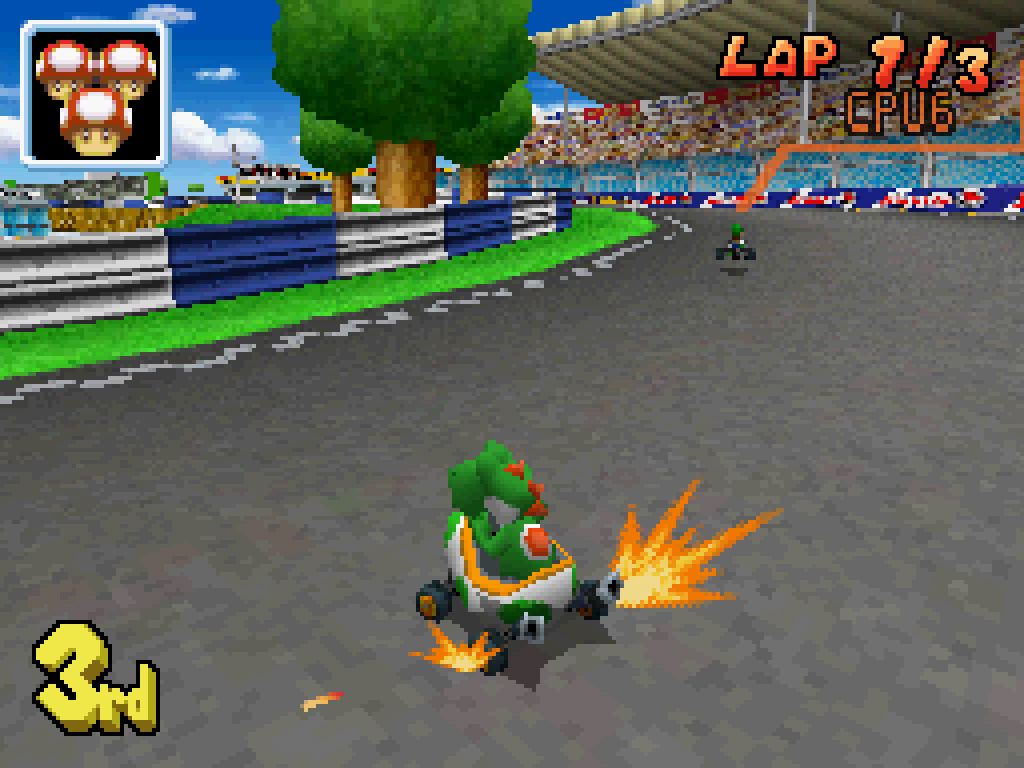
Rounding off the portable entries in the series (and to avoid arguments, let’s call the Nintendo Switch a home console for now), is Mario Kart DS. By far the best handheld experience, it showcased how portable entries in the series should be handled, and if anything is perhaps the biggest contributor to the disappointment felt when Mario Kart 7 launched with very little to add.
Launching back in 2005, four years after Super Circuit, Mario Kart DS was something a bit special, as it was the first game in the series to support an online mode. Utilising the Nintendo Wi-Fi Connection functionality, karters could simply select what mode and who they wanted to go online with (friends or randoms) and the process was relatively painless. Coming from a company with a serious aversion to online capabilities and functionality, this really was a great step forward for Nintendo, and Mario Kart DS itself.
But Mario Kart DS wasn’t just one trick pony. As well as supporting a strong online proposition, where undoubtedly the majority of gamers time would be spent, it also offered a decent single-player mode, with 32 tracks on offer in Grand Prix mode – 16 brand new tracks, and 16 remasters of some of the best tracks from previous games – it also had the standard Time Trial and Vs mode as well as two different battle modes to sink your teeth into. So a lot of content was available – all on a small handheld device, which made Mario Kart DS an essential purchase back when it was released.
#3 Super Mario Kart
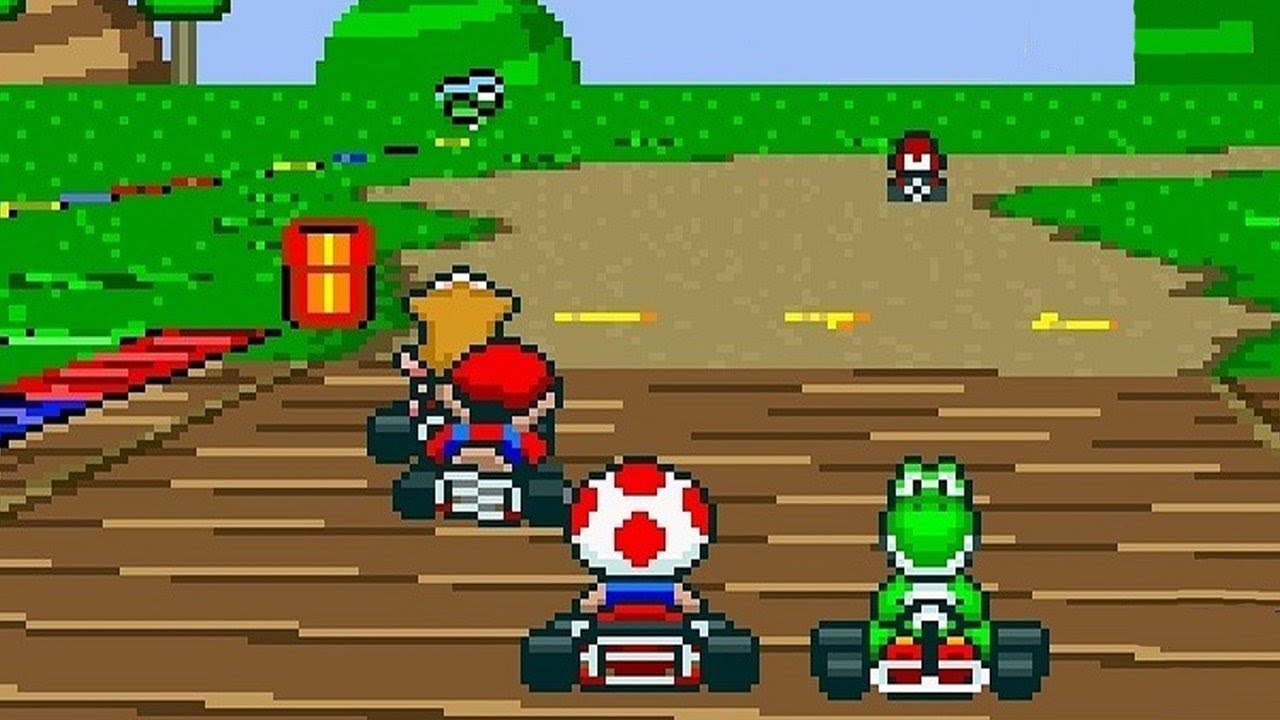
Creeping into the podium positions is the game that started it all. I still remember vividly my first reaction on hearing that Mario was going to appear in a go-kart game. I remember it sounded fun, but I thought it would be a bit rubbish to play, more of a gimmick. Shows what I know eh? But the point was, that this wasn’t just a quick cash-grab starring some recognisable characters, no this was an enjoyable, challenging and well-designed experience, where the karts handled well, and differently depending on who you chose. What that meant back in the early 90s is that a lot of people fell in love with this game, and found themselves sinking countless hours into both the single and multiplayer offerings. I personally remember the sense of achievement at unlocking the special cup, and thinking that was amazing. My mind was blown when I thought the game was done and 150cc unlocked!
An often cited highlight of this game though is the battle mode. Pitting you against another player in local multiplayer, where two racers tried to burst each others balloons by using items against them, and the first to lose theirs was defeated, and the other player the victor. It was a simple idea, that was executed incredibly well, with solid arenas to battle in. It’s a concept that has since been copied – with varying degrees of success – in future Mario Kart instalments and also copycat games throughout the generations.
With it’s incredibly intuitive controls, and course shortcuts, some obvious and some less so, thanks to the game’s iconic Feather item, this was a racer that jump-started a franchise. It’s no surprise then when future instalments of the series are hinted at, that often people simply ask for a remastered version of the original. And for once, that’s not just some dewy-eyed nostalgia, that’s a recognition of a title that was so enjoyable to play, and was Mario Kart in its purest form. There’s a lot to be said for a stripped back experience and Super Mario Kart is just that, a tight, fun, welcoming game that just puts a smile on your face throughout.
#2 Mario Kart Double Dash
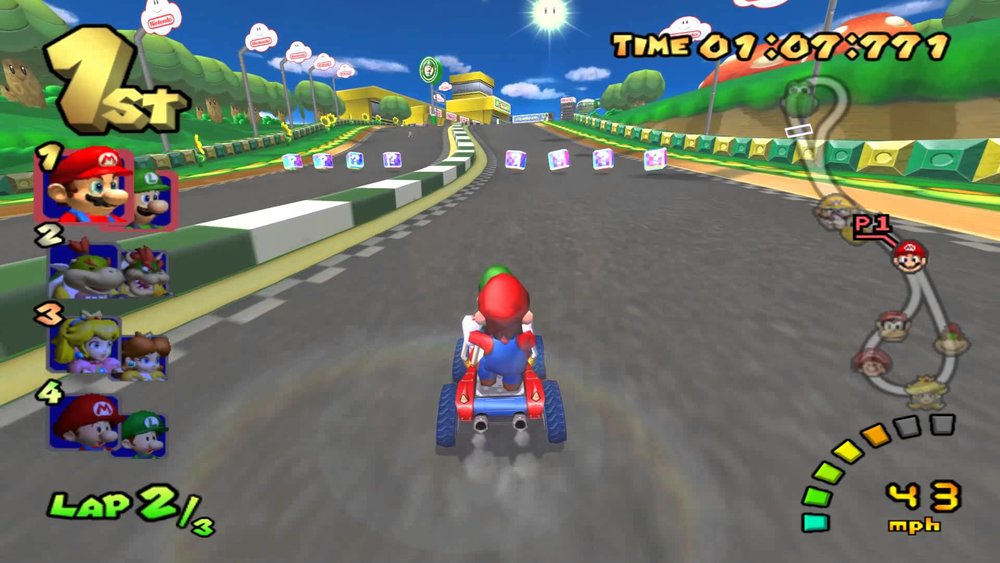
If my Twitter feed is representative of the audience at large, there’s going to be a few jeers that this game was pipped to top spot. And you’ll also know by which game too. But what’s worth appreciating is why Double Dash is loved by some many, to the point where it is put on the top pedestal by so many who have played it. And it seems odd too if we go back to the numbers again. Because Mario Kart Double Dash is the lowest selling console Mario Kart ever. Yes, lower than Mario Kart 8 on the Wii U, despite there being 50% more GameCubes sold compared to the Wii U. So on the face of it, it seems strange, but you have to explore the game itself to understand why.
Firstly the most obvious unique gameplay mechanic was the use of two racers on the same kart. But despite appearance making this seem like a simple gimmick, this allowed for a lot of the charm that was contained within the game itself. Firstly being able to have one person driving, and one person using items, meant true co-op was available for the first time, but the choice of characters this time around meant more than the standard weight, acceleration and top speed – this time each character had a unique item they could use, such as Mario having a fireball, or Donkey Kong having a giant banana skin to lay on the track. This mechanic hasn’t really been used since Super Mario Kart, but then it was restricted to AI having unique weapons, whereas now everyone, human or AI has that benefit. The carnage also increases with the duo dynamic too, as unused items were now discarded on the track if a player was hit, discouraging hoarding of items, and also meaning you could face extra items on the course than before.
What this all added up to was a much more chaotic, but overall fun experience. Mario Kart has never really been about serious racing. Sure the most skilful will bemoan the veering towards the anarchy that can ensue versus a more purist racer, but they’d be missing the point about when Mario Kart is at its best, and that is when people are racing together and enjoying every second, and Double Dash gave them that in droves. With all the action on track, you could be forgiven for not realising that the game also boasts some of the best track designs in the series making an overall game that whilst few (in relative terms) got to experience it, many of them loved it, and adore the game to this day.
#1 Mario Kart 8 (inc. Deluxe)

So the number one spot is here, and yes I’ve sort of cheated, but not really. You see it didn’t feel right to rate Mario Kart 8 on Wii U and the Deluxe version on Switch separately because at their core, they’re the same game. True it’s really the Deluxe version of Mario Kart 8 on the Switch that really earns the top spot, but that would also be underselling what the Wii U game managed to achieve. Its two series predecessors sit at the bottom of this list, and whilst both good games, it’s fair to say the series was in a bit of a lull. Critics needed convincing again about Mario Kart, and it had been nine long years since Mario Kart DS had knocked their socks off.
The new mechanic this time around was the use of anti-gravity, which was implemented very well into the design of the new tracks. It allowed the track designers to explore a whole new opportunity in verticality now that Mario and friends could essentially drive up walls or on the ceilings of structures. And the upshot of this is some of the most varied and unique feeling tracks ever designed in the series. Add to this, the fact that bumping players in anti-gravity zones, and you could gain a speed boost, and a new layer of tactics was added to these sections. So yes, whilst anti-gravity in a Mario Kart game was maybe the final nail in the coffin of a new F-Zero game ever being released, at least we all got treated to some excellent courses to race around.
As is perhaps expected, Mario Kart 8 felt so smooth to race on and built on the fluid game-play that Mario Kart Wii had introduced and improved on it. Whether it be biking, karting, gliding, submerged underwater or driving up a wall, Mario Kart 8 was a joy to play, and the mechanics were incredibly responsive and momentum and steering is the best its has ever felt. The only black spot Mario Kart had against its name was an underwhelming Battle Mode, but that’s where the Deluxe Mode comes to the rescue. Listening to critics, Nintendo updated the Battle Mode to include specially designed courses rather than the existing tracks to do battle in. But Nintendo didn’t stop there with the enhancements, they added a couple of new items into the mix and brought back the ability to hold two items back from Double Dash. As well as that, Deluxe also came with all the DLC tracks – 16 in total – from Mario Kart 8 included up front, meaning a course list of 48 tracks for fans to enjoy.
By building on a strong foundation in Mario Kart 8, it means the Deluxe edition is the most definitive edition in the series, and has to be the one with the highest recommendation from me. Sure it might seem a bit obvious to put that endorsement on the most recent game, but as I’m sure is obvious by now, the Mario Kart series has been far from a continuous improvement over the years. The franchise has had its ups and downs, and right now it’s on a high with Mario Kart 8 Deluxe, no surprise then it has already sold over 10 million copies, and trails only Super Mario Odyssey for software sales on Nintendo Switch. All that remains to be seen is see where Nintendo goes from here, and what new heights it can take the series into in the future.
But that’s just my point of view, what do you think? Are you outraged that I put Mario Kart 7 at bottom? Or do you still believe Double Dash should take the crown? We’d love to hear from you, so let us know your thoughts in the comments section.
Originally published on Aug 24, 2018.


